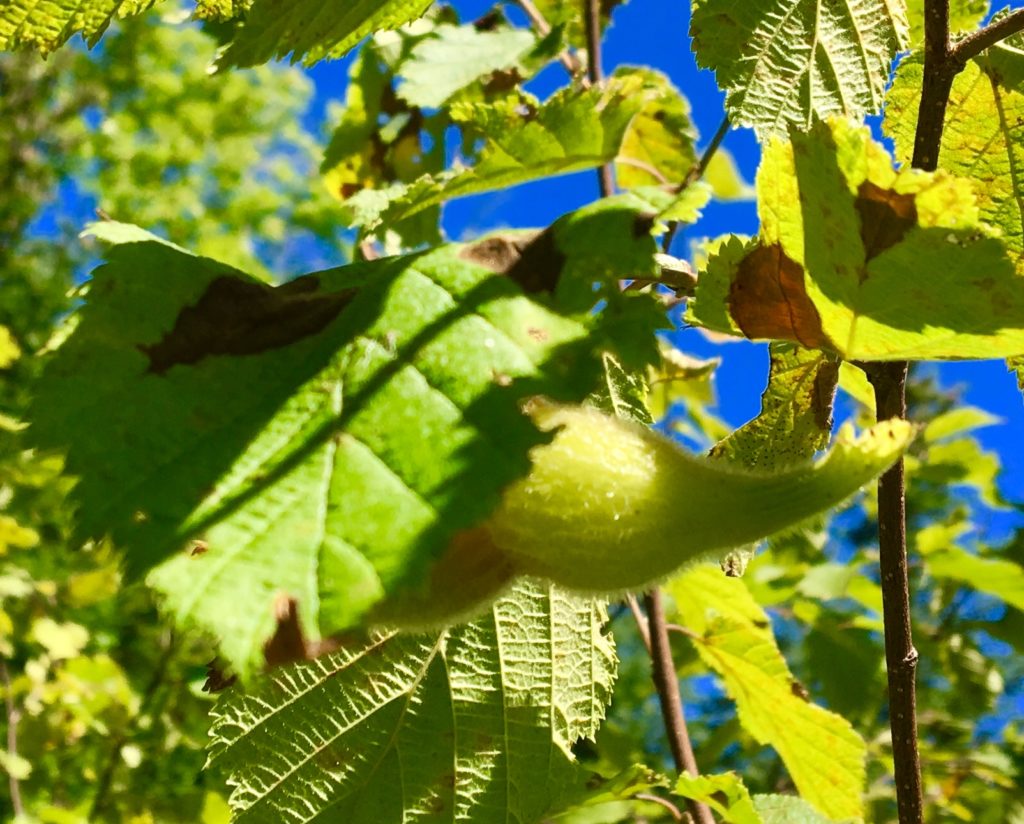Wild hazelnuts are a sweet, prickly end to New England’s foraging season
As New England’s summer winds down, this season’s crop of beaked hazelnuts [Corylus cornuta] is ripening. Now the race is on to see who is going to be the first to harvest that wild edible — humans or wildlife.
Beaked hazelnuts are found in open woodland, along roads, at the edges of forests and near railroad tracks throughout Maine, New Hampshire and Massasahutes.

The hazelnut shrub itself can tolerate shade, but it needs sunlight for the fruit to bloom and grow into nuts, so you are most likely to find the best picking on the sunny sides of fields, roads and other open woodland areas.
Identifying Corylus cornuta
The hazelnut is a woody shrub, according to the United States Department of Agriculture’s online northern research station database grows in a thicket. The shrubs can reach 12- to 15-feet high and have rounded, leaves with serrated — or jagged — edges.
The nuts grow in clusters of two or three — occasionally in fours in a really good year.
On the tree, the nuts are in a bright green casing — or bract — that is covered with small prickles. The casing releases a sticky liquid when crushed that is harmless, but can temporarily stain human skin purple or brown.
The prickles can get lodged in the skin and, while annoying, are not harmful to humans.
Tough nuts to crack
To get at the small, sweet nut you must first peel away that outer prickly bract. It should peel away easily when the nuts are ripe. It’s even easier to peel off if you let the nuts dry in the bract a few days until they start to go from bright green to brown.
Once the bract is off, you are halfway there. The edible part of the hazelnut is inside a hard, brown shell. It requires a nutcracker, hammer or really strong jaws to crack it open.

Some people enjoy them raw, right out of the shell while others will salt and roast them for a tasty snack.
Stored in an airtight bag or container in the refrigerator, unshelled hazelnuts will remain flavorful for six months and up to a year if kept in the freezer.
Know before you go
Wild beaked hazelnuts are high in fats and proteins making them an important food source for squirrels, chipmunks and several bird species. So, tempting as it may be, don’t pick every hazelnut on every shrub.
And while wildlife is exempt from land use and trespassing laws, humans are not, so make sure you check who owns the land where the hazelnuts are growing before you start foraging.
For example, you can pick small quantities of non-protected flowers, berries, nuts or mushrooms on federal Bureau of Land Management land for your own use but not for commercial resale.
Foraging for any plants from any of the country’s National Parks, on the other hand, is strictly prohibited.
Laws on state and private lands can vary among Maine, New Hampshire and Massascusttes.
In Maine, for example, a 2017 law forbids foraging on private land without explicit permission from the landowner.
There are no laws specific to wild edible foraging in New Hampshire, but state common law allows public access to private lands that are not posted for the purpose of hunting. This law is not codified but has been upheld by state courts.
Likewise, there are no foraging laws are on the books in Massachusetts, but laws regarding public access to private land vary among municipalities with some requiring written landowner consent and others implying consent if the land is not posted.
Those Massachusetts municipal laws are available on the website www.mma.org/city-and-town-websites.
In Massachusetts, you can also determine who owns a parcel of land that may hold a treasure trove of hazelnuts by going to http://maps.massgis.state.ma.us/map_ol/oliver.php and zooming over the area in which you are interested.
In all cases, it is always a good idea to check with the landowner before foraging for hazelnuts or any wild edible.
